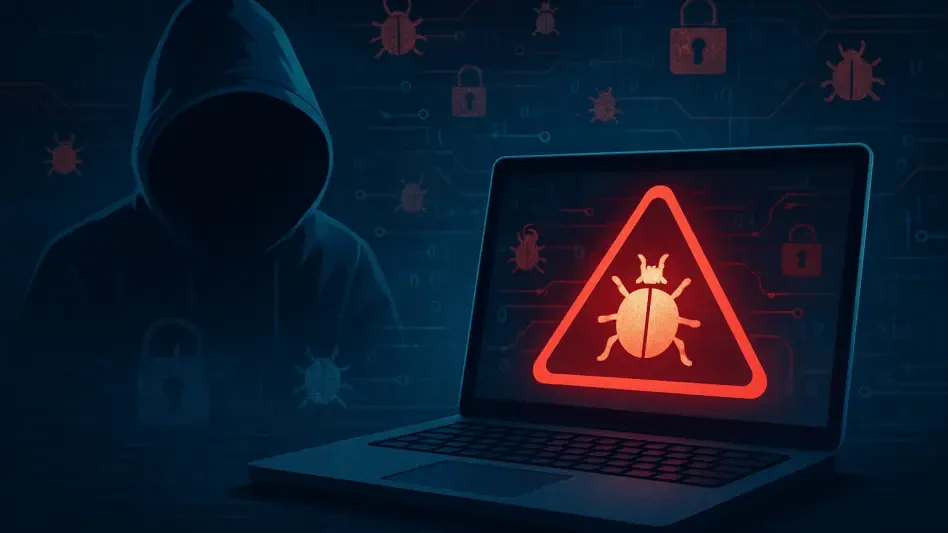The digital landscape is under siege, with a staggering number of cyber incidents reported each day, but few threats are as insidious as a newly emerged Remote Access Trojan (RAT) making waves on underground forums. Advertised as a fully undetectable alternative to legitimate remote access tools like ScreenConnect, this malware represents a chilling evolution in cybercrime. Its ability to infiltrate systems unnoticed while masquerading as trustworthy software raises critical questions about the security of everyday digital interactions. This review explores the sophisticated mechanisms behind this RAT, shedding light on why it has become a focal point for cybersecurity experts.
Beyond its deceptive facade, this RAT is engineered to facilitate a range of malicious activities, from data theft to system manipulation. Its emergence signals a broader trend of increasing sophistication among cybercriminals, who are leveraging advanced tactics to bypass modern defenses. This analysis aims to dissect the core features of this threat, evaluate its impact, and consider the challenges it poses to current security frameworks.
Technical Breakdown of a Sophisticated Threat
Deceptive Trust through Extended Validation Certificates
One of the most alarming aspects of this RAT is its use of valid Extended Validation (EV) certificates to evade suspicion. These certificates, typically associated with legitimate entities, trick security mechanisms like Google Chrome’s warnings and Windows SmartScreen by displaying visual trust indicators such as green bars or company names. This creates a false sense of safety for users, who are conditioned to associate such cues with authenticity.
The impact of this deception is profound, as it directly influences user behavior. Unsuspecting individuals are more likely to download or interact with malicious content when it appears credible, significantly increasing the success rate of malware deployment. This tactic underscores a critical vulnerability in how trust is established in digital environments, where visual cues can be weaponized with devastating effect.
Evasion Mastery with Antibot Systems and Cloaked Pages
Further enhancing its elusiveness, this RAT employs antibot mechanisms alongside cloaked landing pages to dodge automated security scans and sandbox environments. These pages are designed to present benign content to scanning tools while delivering malicious payloads to genuine users, effectively hiding the true nature of the threat. Such techniques exploit the limitations of automated detection systems that struggle to mimic human interaction.
A striking example of this social engineering prowess is a fraudulent Adobe Acrobat Reader download page, crafted to appear legitimate to unsuspecting visitors. This deceptive delivery method not only bypasses technical defenses but also preys on user trust in familiar software brands. The result is a seamless infection process that often goes unnoticed until significant damage has occurred.
Stealthy Operations via PowerShell Execution
The RAT’s ability to execute commands through PowerShell adds another layer of stealth to its arsenal. By utilizing a fileless approach, it avoids leaving traditional footprints on disk, a tactic that renders many conventional antivirus solutions ineffective. This method ensures that the malware can operate covertly, embedding itself deep within compromised systems.
Such stealthy execution enhances the RAT’s persistence, allowing it to maintain access over extended periods without triggering alerts. This capability poses a significant challenge to security teams, who must now contend with threats that evade standard detection protocols. The reliance on memory-based operations signals a shift toward more elusive malware strategies in the cybercrime domain.
Real-Time Manipulation and Data Theft Capabilities
Equipped with a remote viewer feature, this RAT grants attackers real-time control over infected systems, enabling direct interaction and monitoring. This functionality allows for immediate manipulation of files, applications, and settings, turning a compromised device into a puppet under the attacker’s command. The implications for privacy and security are dire, as sensitive activities can be observed without the user’s knowledge.
Additionally, the RAT excels at data exfiltration, siphoning off critical information with ease. Its design also supports the deployment of secondary payloads, such as ransomware or spyware, amplifying the potential for widespread harm. This multifaceted threat profile makes it a versatile tool for various malicious objectives, from financial gain to espionage.
Cybercrime Trends and Market Dynamics
The rise of this RAT reflects a broader trend in cybercrime, where attackers increasingly mimic legitimate software to exploit user trust. By presenting malware as trustworthy alternatives to known tools, threat actors bypass both technical and psychological barriers to entry. This strategy highlights a growing sophistication in how cybercriminals approach their craft, focusing on deception as much as technical innovation.
Moreover, the operationalization of such threats is evident in the professional marketing and distribution models adopted by sellers. Offering demos and promising rapid delivery within 24 hours, the creators of this RAT treat their malware as a polished product in a competitive underground market. This commercialization of cybercrime tools lowers the barrier to entry for less-skilled actors, expanding the threat landscape significantly.
Challenges in Countering an Invisible Enemy
Detecting this RAT proves to be a formidable challenge due to its ability to remain hidden during both static and runtime analysis. Traditional security tools, which often rely on signature-based detection, struggle to identify threats that leverage legitimate-looking certificates and cloaked delivery mechanisms. This gap in detection capabilities allows the malware to establish a foothold before any defensive action can be taken.
The limitations of current security measures are further compounded by the rapid evolution of evasion tactics. As cybercriminals adapt to countermeasures, an ongoing arms race unfolds, pushing the boundaries of what detection systems must achieve. Addressing these challenges requires a fundamental shift toward more dynamic and behavior-based analysis to uncover hidden threats.
The complexity of this RAT also emphasizes the need for enhanced collaboration between security professionals and software vendors. Developing robust strategies to validate trust indicators and educate users on recognizing deceptive tactics is essential. Without such efforts, the gap between attack sophistication and defensive capabilities will continue to widen.
Reflecting on a Formidable Adversary
Looking back, the detailed examination of this Remote Access Trojan reveals a highly sophisticated threat that challenges even the most advanced security frameworks. Its use of EV certificates, cloaked delivery methods, and fileless execution underscores a level of ingenuity that demands urgent attention from the cybersecurity community. The real-time control and data exfiltration features further cement its status as a versatile and dangerous tool in the hands of malicious actors.
Moving forward, actionable steps must include the development of more adaptive detection technologies that prioritize behavioral analysis over static signatures. Strengthening user education to recognize deceptive trust indicators, such as seemingly legitimate certificates, should be a parallel focus. Collaborative efforts between industry stakeholders to share threat intelligence can also play a pivotal role in staying ahead of such evolving dangers.
Ultimately, the fight against this RAT and similar threats hinges on anticipating the next wave of cybercrime innovations. Investing in proactive measures, from advanced machine learning algorithms to comprehensive awareness campaigns, will be critical in safeguarding digital environments. As the landscape continues to shift, a commitment to resilience and adaptability remains the best defense against these unseen adversaries.








